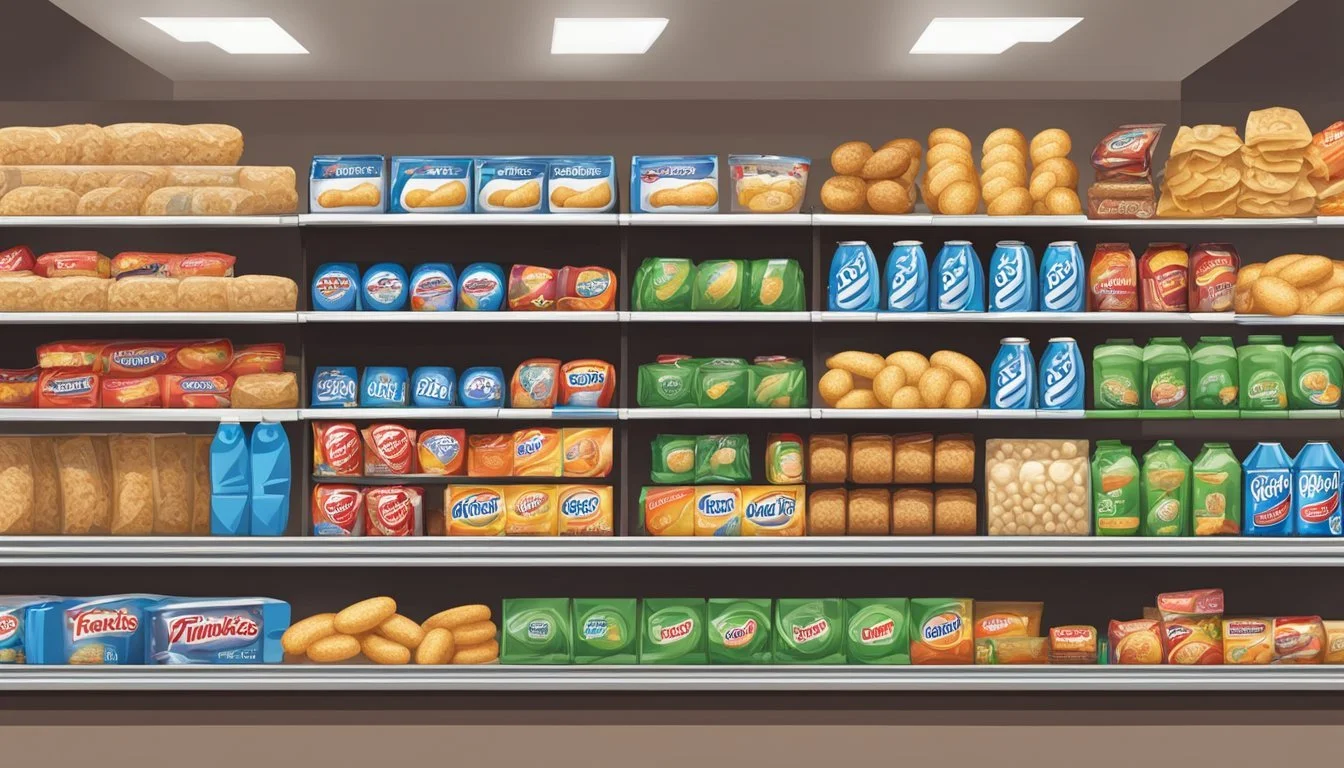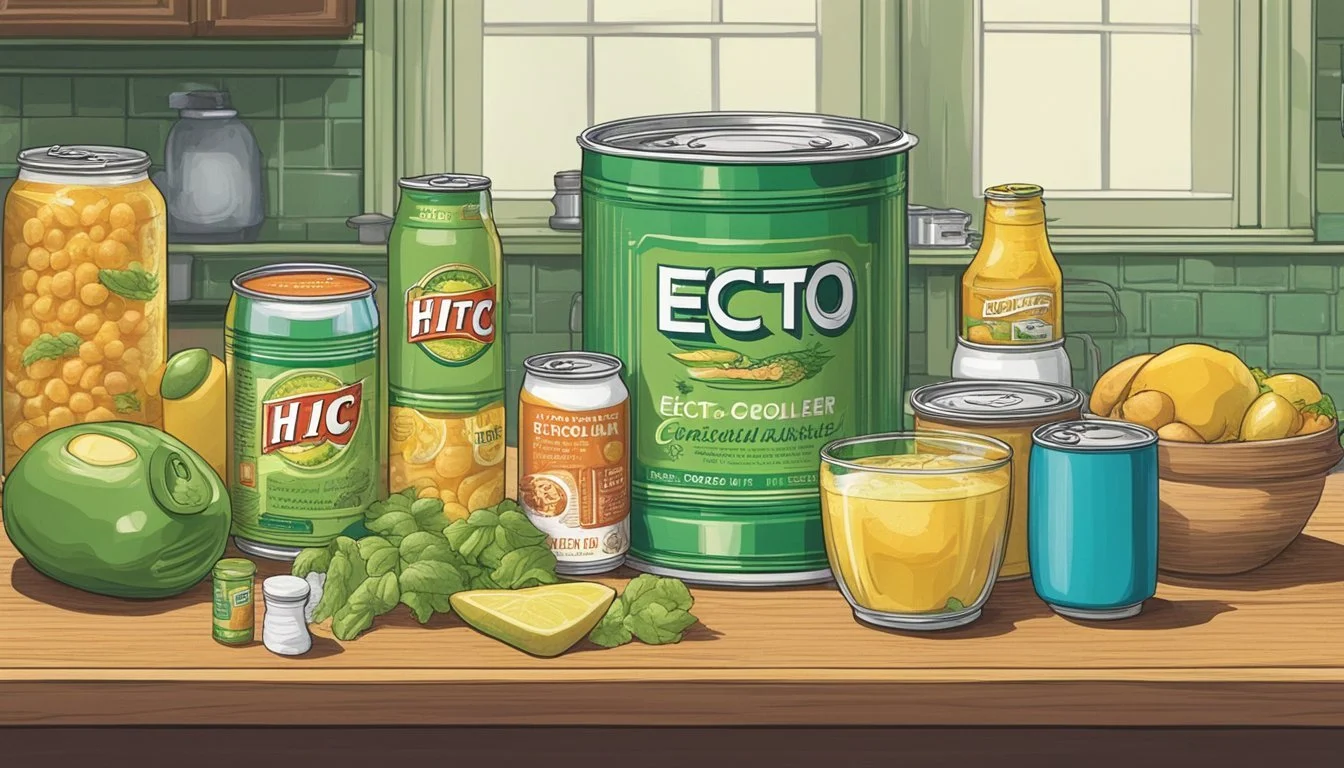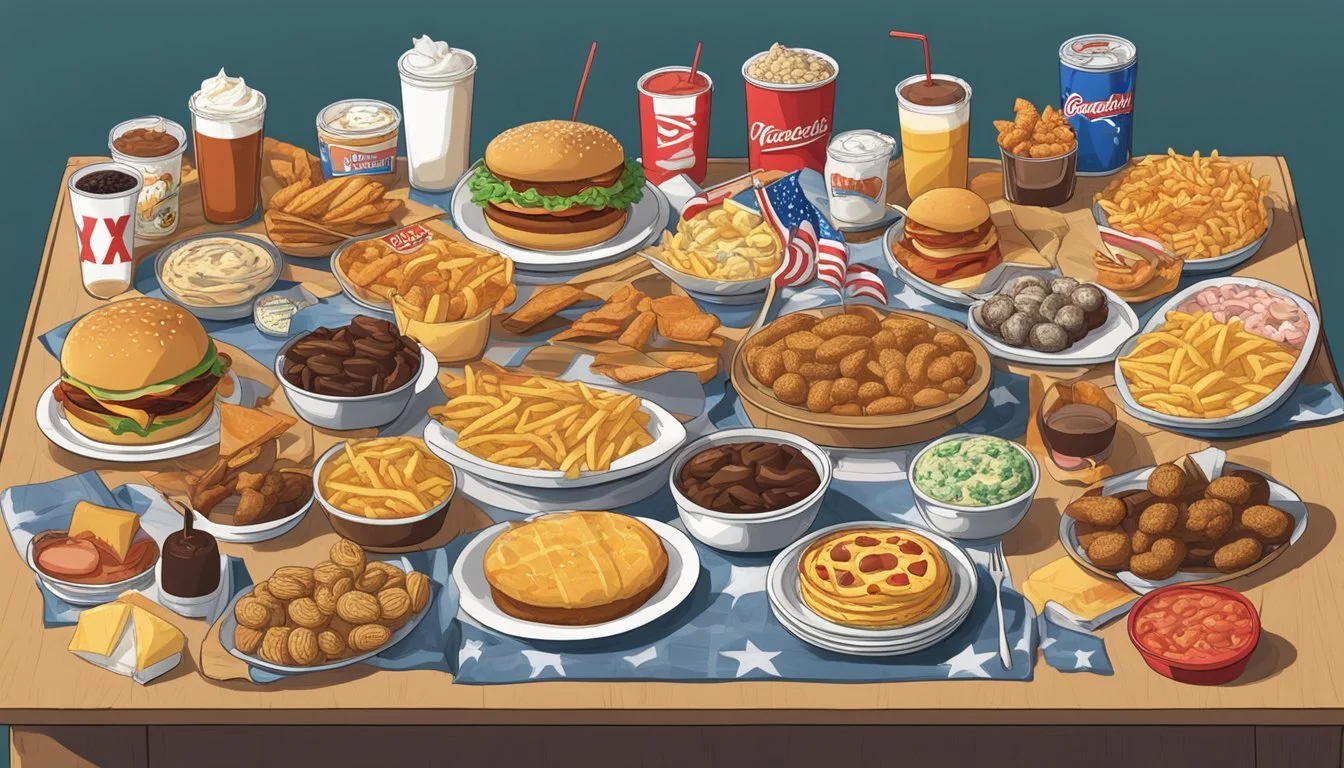10 Food You Can No Longer Buy in the USA
What's Missing from Shelves
Navigating the evolving landscape of available food items in the United States can be both perplexing and fascinating. Periodically, certain foods are banned, restricted, or discontinued for a variety of reasons ranging from health regulations to changes in consumer preferences.
Understanding why these foods disappear can provide insight into the cultural and regulatory environment of the country. Exploring which foods you can no longer find in the USA not only sheds light on past favorites but also highlights the dynamic nature of the food industry.
1) Butterfinger BB's
Butterfinger BB's were a beloved candy introduced in 1992 by Nestlé. These small, round treats were essentially bite-sized versions of the classic Butterfinger bar, featuring a crispy, crunchy peanut butter core coated in milk chocolate.
The popularity of Butterfinger BB's soared in the '90s, partially thanks to memorable ad campaigns often featuring The Simpsons characters. Despite their success and a strong fan base, Butterfinger BB's were discontinued in 2006.
Many fans speculate that the discontinuation was due to melting issues and production difficulties. Despite their departure from store shelves, Butterfinger BB's remain a nostalgic favorite, with many people hoping for their return.
2) Planters Cheez Balls
Planters Cheez Balls were once a beloved snack from the 1990s. Known for their distinctive cheese flavor and light, crunchy texture, they were a hit among snack enthusiasts.
These bright orange puffs were sold in iconic blue canisters. Many people remember enjoying them as a staple at parties, movie nights, and casual gatherings.
In 2006, Planters Cheez Balls were discontinued, much to the disappointment of their fans. The decision left many searching for alternatives that could match the nostalgic snack's unique characteristics.
In 2019, Planters temporarily brought back Cheez Balls due to popular demand. The excitement was short-lived as they were not consistently available in stores.
As of now, Planters Cheez Balls are no longer a regular item on store shelves in the USA. Fans continue to reminisce about the crunchy, cheesy goodness.
3) Hi-C Ecto Cooler
Hi-C Ecto Cooler debuted in 1989, featuring a ghostly green color and an orange-tangerine flavor reminiscent of citrus drinks from earlier decades. The beverage gained instant popularity, partly due to its tie-in with the animated series "The Real Ghostbusters."
Featuring Slimer, the green ghost from the Ghostbusters franchise, on its packaging, Ecto Cooler became an iconic drink for children in the late '80s and '90s. Its vibrant color and marketing made it a standout product.
The drink was discontinued in 2001, much to the disappointment of its fans. It made a brief return in 2016 to coincide with the release of the Ghostbusters reboot movie, but this relaunch was short-lived.
Ecto Cooler has been the subject of many DIY recipes, with fans attempting to replicate its unique flavor at home. Occasionally, limited releases spark frenzied buying sprees by nostalgic consumers.
Despite its discontinuation, Ecto Cooler's legacy lives on. Vintage packs sometimes appear on auction sites, fetching high prices from collectors. Its cult status underscores the lasting impact of this uniquely marketed beverage.
4) Jell-O Pudding Pops
Jell-O Pudding Pops gained immense popularity in the 1980s. They were a refreshing frozen treat, beloved by both children and adults. Within five years of their debut, these pops were generating significant sales, amounting to $300 million.
Despite their success, General Foods, the company behind Jell-O Pudding Pops, faced challenges. They struggled to maintain profitability. General Foods lacked experience in the frozen food market, which led to operational difficulties.
Attempts to sustain Jell-O Pudding Pops were not enough. Declining sales and operational struggles meant that Pudding Pops slowly disappeared from store shelves. By the 1990s, they were discontinued, leaving many fans disappointed.
Although some brands tried to imitate Jell-O Pudding Pops, none managed to capture the same appeal. For those who miss this frosty treat, DIY recipes have surfaced. These allow nostalgic fans to recreate the dessert in their own kitchens.
While Jell-O Pudding Pops no longer occupy a spot in grocery stores, they remain a fond memory for many.
5) Taco Bell's Bell Beefer
Taco Bell's Bell Beefer made its debut in the 1970s. It featured the chain's signature seasoned beef, lettuce, tomatoes, and cheese, but instead of the usual taco shell, these ingredients were placed between a hamburger bun.
This gave the Bell Beefer a unique twist and set it apart from other menu items, appealing to fans who preferred a sandwich-style option.
Despite its popularity among some customers, the Bell Beefer was eventually discontinued. Its departure left a void for those who enjoyed its distinct blend of flavors.
Though it no longer graces Taco Bell's menu, the Bell Beefer remains a nostalgic favorite for many who remember its unconventional take on fast-food cuisine.
6) Nestlé Alpine White
Nestlé Alpine White was a white chocolate bar embedded with almonds. It first appeared in U.S. stores in 1986 but didn't last long in the market. Nestlé attempted to position it as a premium product, targeting white chocolate aficionados.
Despite its unique offering, Alpine White didn't gain enough traction with consumers. The bar’s creamy texture and almond mix couldn't secure a lasting impression.
Nestlé sold its American candy division to Ferrero in 2018, which included iconic brands like Butterfinger and Crunch. Alpine White, discontinued long before this sale, remains a nostalgic memory for those who experienced its brief time on shelves.
A memorable 1986 commercial, showcasing the Alpine White bar in a dramatic, moody setting, still circulates online. Fans who miss the chocolate bar have even created a Facebook page petitioning for its return. Despite these efforts, Nestlé Alpine White remains a fond but distant memory.
7) Keebler Magic Middles
Keebler Magic Middles were a beloved treat that held a special place in many American households. Introduced in the late 1980s, these cookies featured a soft shortbread exterior with a delicious chocolate or peanut butter-filled center.
Magic Middles became a hit almost immediately. By 1990, Keebler introduced additional varieties, including chocolate chip and peanut butter, to cater to a wider audience.
Despite their popularity, by the early 2000s, Magic Middles were discontinued. The exact reasons for their disappearance remain unclear, but fans have long speculated about production costs and changing consumer preferences.
In 2021, Keebler suggested on social media that they would pass on fans' requests for the cookies' return. Despite this glimmer of hope, Magic Middles have yet to make a comeback.
The nostalgia for Magic Middles persists. They are often cited in articles and forum posts discussing long-lost favorite snacks. Fans remain hopeful that these iconic cookies might someday return to store shelves.
8) Pepsi Blue
Pepsi Blue was introduced in 2002, aiming to capture the attention of teenagers with its berry flavor and striking blue color. It stood out from the classic cola options, making it a unique offering in the soda market.
Despite its bold introduction, Pepsi Blue struggled to maintain its initial momentum. It was eventually discontinued, as sales did not meet expectations.
In 2021, Pepsi briefly reintroduced Pepsi Blue for a limited time, tapping into nostalgia for early 2000s products. The limited release generated buzz but was short-lived, confirming that Pepsi Blue is no longer a staple on store shelves.
9) McDonald's Arch Deluxe
The McDonald's Arch Deluxe, introduced in the mid-1990s, aimed to attract a more sophisticated adult palate.
This burger featured a quarter-pound beef patty, a special sauce, crisp lettuce, tomato, onion, American cheese, and a sesame seed bun.
The burger's marketing campaign emphasized its "grown-up" taste, a shift from the brand's traditional family-focused image. Despite these efforts, the Arch Deluxe did not meet sales expectations and was discontinued.
Various attempts to recreate the burger's unique sauce have highlighted its slightly sweet and tangy flavor, with ingredients like mayo, brown mustard, honey, and horseradish.
The failure of the Arch Deluxe serves as a notable example of how even well-established brands can struggle with innovating their product lines.
10) Wendy's SuperBar
Wendy's SuperBar was a unique feature in the fast food industry from 1988 to 1998. This all-you-can-eat buffet offered a mix of different cuisines, making it stand out in a market dominated by burgers and fries.
The SuperBar included three main stations. The "Garden Spot" featured fresh salads and a variety of toppings. The "Pasta Pasta" station provided different types of pasta and sauces, including a popular garlic bread made from hamburger buns.
Additionally, the "Mexican Fiesta" section offered tacos, Spanish rice, and an array of toppings. This diverse offering allowed patrons to customize their meals, adding a level of variety uncommon in typical fast food establishments.
Despite its popularity, the SuperBar was discontinued after 10 years. Operational costs and the complexity of maintaining such a varied buffet were reasons behind its removal. Its departure left many fans nostalgic for the unique dining experience it provided.
Historical Context of Food Restrictions
Understanding the development of food regulations and their impact on consumer choices is crucial. These regulations have been shaped by scientific discoveries, public health concerns, and consumer safety needs.
Evolution of US Food Regulations
Food regulations in the United States have evolved significantly since the late 19th century. The first federal food protection law was enacted in 1883 to prevent the importation of adulterated tea. By 1896, the oleomargarine statute was passed due to objections from dairy farmers to the sale of colored and adulterated butter.
The 1906 Food and Drugs Act marked a major milestone by addressing false and misleading statements about food and drugs. However, it wasn't until the 1911 Supreme Court ruling in U.S. v. Johnson that the need for more robust laws became evident, as the ruling pointed out the act did not cover false therapeutic claims.
The 20th century saw increased focus on specific ingredients like trans fats and chemicals. For example, trans fats were commonly used due to their stability and flavor but were banned in 2018 when linked to heart disease. These evolving regulations reflect ongoing efforts to enhance food safety and public health.
Impact of Food Laws on Consumer Choices
Food laws have profoundly influenced what consumers find on their grocery store shelves. The ban on trans fats, for instance, led manufacturers to reformulate many baked goods, snacks, and fried foods. This change aimed to reduce heart disease risks among the public.
Such regulations ensure not only safety but also transparency. For example, labeling requirements help consumers make informed decisions about their dietary choices. The emphasis on food safety has also led to the elimination of controversial additives and ingredients.
Public concerns around foodborne illnesses and nutritional quality have continuously driven reforms. By restricting certain foods and ingredients, U.S. food laws strive to protect consumer health while nudging the market towards safer and healthier products.
Health and Safety Concerns
Several food items are no longer available for purchase in the United States due to severe health risks and regulatory decisions. This section explores the reasons behind these bans and the role of the FDA in ensuring food safety.
Reasons Behind Food Bans
Many foods have been removed from the U.S. market for containing harmful substances or for causing health issues. For instance, brominated vegetable oil and potassium bromate have been linked to cancer and other serious conditions. Red Dye No. 3 is another banned ingredient due to its association with thyroid tumors.
Certain imported foods are also banned due to contamination risks. Contaminated cantaloupe led to multiple hospitalizations and deaths in recent years. Soft cheeses and deli meats, prone to Listeria contamination, pose significant health hazards.
Other bans relate to environmental concerns. The mirabelle plum is not banned for health reasons but is protected from importation to maintain its designation as a "protected origin" food.
Role of FDA in Food Safety
The U.S. Food and Drug Administration (FDA) plays a critical role in maintaining food safety. It regulates food additives and monitors foodborne illness outbreaks. The FDA's regulatory framework includes setting safety standards for various food products.
When issues arise, the FDA issues recalls and alerts to the public. For instance, recent recalls of contaminated cantaloupe and deli meats highlighted its role in protecting public health. The FDA also enforces bans on dangerous food additives such as titanium dioxide, known for causing health issues.
The FDA's effectiveness sometimes faces criticism due to delayed responses. However, its regulatory efforts are essential in removing hazardous foods from the market, ensuring the public consumes safe, healthy products.
Cultural and Economic Implications
The restriction of certain foods in the United States has both cultural and economic consequences. Examining the impact on local businesses and shifts in consumer habits provides clarity on these effects.
Effects on Local Businesses
Local businesses are significantly impacted when popular imported foods become unavailable. Specialty stores that once thrived on selling unique international items face revenue losses.
Restaurants that rely on these ingredients may need to adjust menus, which can reduce customer satisfaction. Import restrictions also affect distributors and supply chains, disrupting the market.
Some businesses attempt to recreate banned items, but this isn't always successful. They may not capture the authentic taste, leading to reduced consumer interest. Economic hardships for businesses can result in layoffs and declining local economies.
Shift in Consumer Habits
Consumer habits often shift when beloved products are banned. People may seek alternatives or substitutes, changing purchasing patterns. This can increase demand for domestic versions or other imported products.
Shoppers also turn to online sources or underground markets to obtain restricted items. Such changes in behavior reflect adaptability but come with risks, including increased costs or potential legal issues.
Bans may encourage some consumers to explore new foods and diversify their diets. Ultimately, these shifts demonstrate resilience and the continual evolution of consumer preferences.






